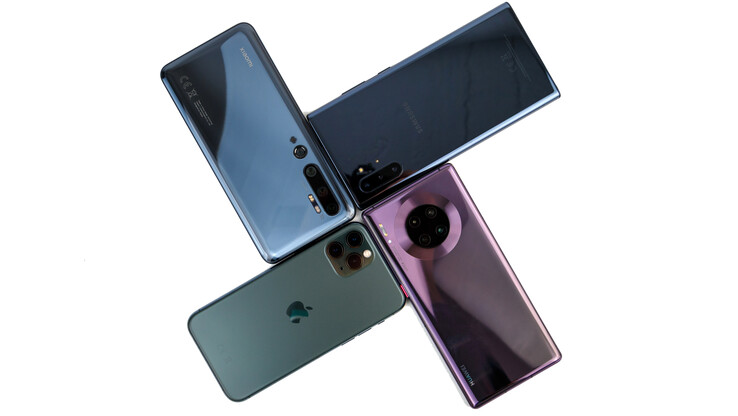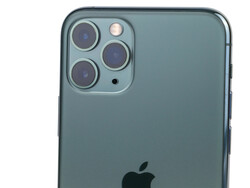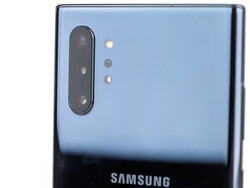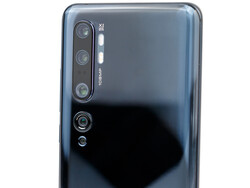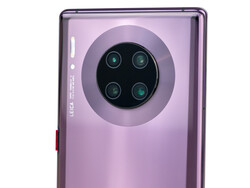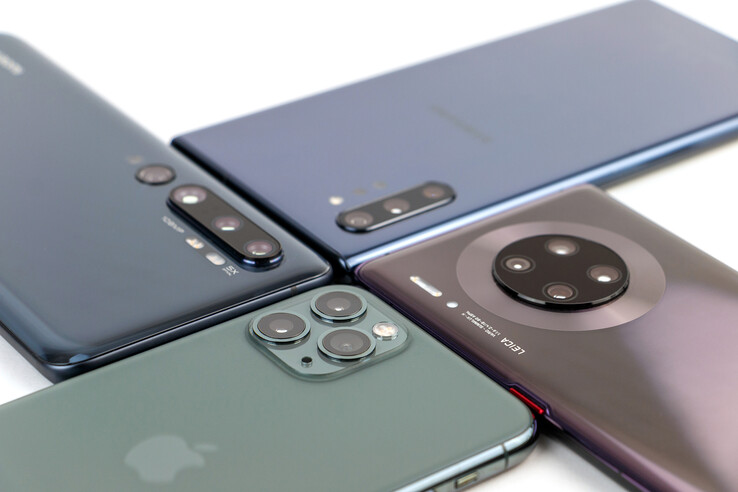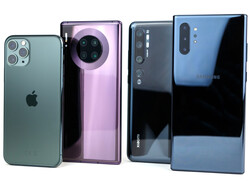The best video smartphones in the test: All against the iPhone
The iPhone has the reputation of being the first choice for video recordings and offers a wide range of options in this regard. The competition from the Android warehouse has been upgraded and has legitimate ambitions to contest the Apple phone for the throne.
Huawei even integrates an additional 40 MP image sensor, while Samsung uses a very similar setting to Apple in the Galaxy Note 10 Plus. The Xiaomi Mi Note 10 is much cheaper, but with a swanky 108 MP sensor it nominally opens the widest shooter. The upcoming Galaxy S20 series would certainly also be an exciting candidate because the devices can handle 8K video, among other things, but unfortunately they were not yet available at the time of testing.
The following table provides an initial overview.
| - | iPhone 11 Pro | Galaxy Note10+ | Mate 30 Pro | Mi Note 10 |
|---|---|---|---|---|
| Main sensor | 12 MPix, 1/2.55", f/1.8 | 12 MPix, 1/2.55", f/1.5 bzw. f/2.4 | 40 MPix, 1/1.54", f/1.8 | 108 MPix, 1/1.33", f/1.69 |
| Full HD | 24/30/60 FPS | 30/60 FPS | 30/60 FPS | 30/60 FPS |
| Ultra HD | 24/30/60 FPS | 30/60 FPS | 30/60 FPS | 30 FPS |
| Data rate UHD (30 FPS, H.264) | 45 MBit/s | 47 MBit/s | 37 MBits/s | 41 MBit/s |
Features - Xiaomi with many lenses and megapixels, but with few frame-rate options
The iPhone uses a triple camera setup, which in addition to the standard wide angle offers both an ultra wide angle and a double optical magnification. All three optics have the maximum video resolution in Ultra HD at up to 60 frames per second. You can switch back and forth between all three lenses during the recording. The iPhone is also the only smartphone that enables 24, 30, and 60 FPS. In low-light conditions, the frame rate can also be reduced automatically to capture more light.
The Samsung Galaxy Note10 + uses a similar setting, but this is supplemented by an additional camera for the depth calculation. This should also allow a considerable bokeh effect in video mode, unfortunately this was not quite convincing during the test. Although the effect is somewhat improved, the contours always result in image errors and imprecise transitions, even if the person is standing still, which is why we would not use it. With the Note10 + you can also switch between the different optics.
The Xiaomi Mi Note 10 has the most camera lenses, of which the main sensor has a powerful 108 MP resolution, but it is the only smartphone in the comparison field that cannot record UHD videos at 60 fps. Switching between the individual cameras is also only possible to a limited extent. For example, if you start your video with the ultra wide angle, you can use the full digital zoom, but if you start with an enlargement, you can no longer go back to the ultra wide angle. The 2 MP macro sensor does not have enough resolution for UHD, but it does support the main sensor in macro filming. The Note 10 thus has many options, but it can take some time getting used to it.
Huawei shows off with the Mate 30 Pro because the smartphone has its own sensor for videography, which is also reserved for ultra-wide-angle photos. The sensor is comparatively large and can capture more light accordingly; this should offer advantages, especially in the dark. The Mate 30 Pro also has a bokeh mode for videos, which is also not convincing and has to deal with the same problems as the Samsung phone. The remaining lens offers a triple optical zoom, which can also be expanded digitally up to 10 times when filming.
All smartphones have optical image stabilization for both wide-angle and telephoto zoom.
Videos by day - iPhone and Mi Note 10 surprise
The main optics for video are the focus of all the tests. Since the additional lenses often only provide poorer image quality, we will not go into them in detail. All recordings during the test were recorded in Ultra HD at 30 fps.
All candidates perform well in daylight, but the iPhone can prevail here with the most balanced image. The white point is also very good. The three Android devices all struggle with partial overexposure, or they even show small burned-out areas of the image. The Mi Note10 is particularly positive here, which falls back in the details, but it manages a balanced exposure.
By using the ultra-wide-angle sensor, the Mate 30 Pro suggests an almost crop-free picture, while the opponents show a smaller image section. The curvature on the sides is also clearly visible here. Anyone who believes that they can easily achieve the same effect with the ultra-wide-angle lenses of the other smartphones could be disappointed, because with a native playback on a large panel, the poorer performance of the smaller image sensors can still be recognized and is expressed by a permanent noise; especially the Mi Note 10 is negative in this regard.
If you like to use the zoom in videos, Huawei and Samsung offer you the greatest flexibility, because they both master the stepless zoom, starting with the ultra wide angle up to a tenfold digital magnification. While the Galaxy smartphone uses the three conventional lens buttons to switch between the focal lengths, the Mate 30 Pro uses a slider to simulate camera movement that moves faster the further it is pushed from the center. That looks pretty good, but sometimes it works a little quickly, so the tracking shot quickly misses the target. In addition, there is a visible change in the white balance when switching to the next lens or only zooming digitally. This is particularly evident in the Xiaomi mobile phone, while the iPhone copes with the transition cleanly. These two can digitally zoom up to six times.
Under controlled lighting conditions, the differences in white balance are immediately apparent. While Samsung and Apple manage this quite naturally, the two Chinese models show a visible green tinge. The Galaxy Note 10+ has the sharpest image in the center but shows a slight fragmentation in the colored areas. The Mate 30 Pro copes best with the latter, but the opponents are close together in this area.
With the maximum zoom on our test chart, Apple surprisingly has the edge. It tracks the focus very quickly and keeps it stable. Samsung can also convince in this regard. The other two Androids have much more problems focusing. In general, the Mate 30 Pro was sometimes wrong with the autofocus and focused on the background instead of the subject, while the Mi Note 10 did not always focus at the focus points.
Videos in low light - Huawei turns night into day, but...
In order to be able to assess the video performance of smartphones in low light, we took pictures in different lighting conditions. What immediately stands out: The Xiaomi Mi Note 10 performs the worst here under all conditions and not only in a scarce manner but very clearly visible.
In the first setting, only the iPhone 11 Pro and the Mate 30 Pro manage to capture part of the light from the approaching sunrise and to work out the contours properly. The latter works better on the iPhone, while the play of colors in the sky can only be guessed at on the Huawei.
Around an hour later, it is already visibly brighter. Here the optics seem to turn up a lot and gather a lot of light onto the sensor. But as a result, there is only a lot of mud and subjects that are far too bright. The Mate 30 Pro captures the scenery most naturally, but the most-balanced shot is provided by the iPhone.
Under controlled lighting conditions, we first test all smartphones at 3 lux, which roughly equates to dim cellar lighting. Here, too, Apple chooses a pleasing balance between brightness and sharpness, and the iPhone's autofocus works most reliably in these lighting conditions. The Mate 30 Pro collects a lot of light and the subject is well lit, but it shows a lot of weaknesses in the details, especially towards the edges. Samsung also relies fully on brightness, but this is visibly at the expense of quality.
At 0.5 lux it's pretty dark. In this setting, the Mi Note 10 shows itself as a total failure and the other smartphones also reach their limits. The iPhone and the Mate 30 Pro still capture the most light here, and they still manage to generate a reasonably usable image, but the Huawei phone does not do this with the video sensor, but with the standard wide angle. In addition, the AIS of the Mate 30 Pro has visible problems in low-light conditions to compensate for movements, which can result in a vibrating image in the video sensor.
Sound - Sure thing
There are big differences in the microphones. Outdoors, on windy days, the iPhone and the Mi Note 10 are particularly susceptible to wind noise, while the Galaxy Note 10 + filters them out as much as possible, so that they can only be guessed as a slight whisper in the background. Huawei chooses the eeriest route: It tries to suppress the wind noise but instead records a strangely distorted wind. Light gusts of wind can all be compensated for quite reliably.
In quiet environments, the microphone of the Samsung mobile phone is particularly sensitive and also records quiet voices clearly and easily. The Mate 30 Pro also delivers low-noise audio recording, but it is accompanied by a slight hum. The iPhone is a noiseless model child, which filters out even quiet ambient noises and delivers a very good sound recording.
Only the Xiaomi smartphone shows weaknesses here, because its tone is comparatively quiet and is accompanied by an audible noise.
Verdict - Apple offers the most balanced setup
With the iPhone 11 Pro, Apple lives up to its reputation of having the best smartphone for videography. However, it is not absolutely top-notch in all areas. All the smartphones deliver good to very good results in daylight. In comparison, Huawei is cool as usual, while Samsung and Xiaomi do not illuminate quite as harmoniously as Apple. The Mi Note 10 additionally has to make a few small cuts in the details.
In low ambient light, the big price difference is noticeable despite the modern image sensor of the Mi Note 10. The Xiaomi phone captures less light, and image noise is visible earlier compared to its more expensive competitors. The focus tracking is not always clean or has to be initiated manually, and the smartphone's camera also shows problems switching between the individual optics.
Xiaomi surprises with a good performance, although the Mi Note 10 doesn't even cost half of the more-expensive rivals.
Huawei also shows problems with the autofocus, but especially in low light the Mate 30 Pro flexes its muscles. However, this is often at the expense of details. Also the lack of optical image stabilization for the video sensor has a negative impact, especially in low light, where the AIS can sometimes be incorrectly stabilized or adjusted. Above all, Apple does a lot of things right and chooses a successful path between image brightening and level of detail.
Ultimately, the iPhone can outperform the competition, especially in the field of sound recording, and only the Galaxy Note10 + can keep up here and is even audibly better in windy situations.




